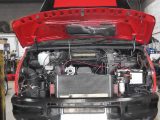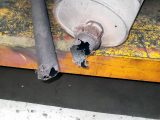Realising that your ’van is due its engine cambelt service is a sobering thought. A normal service involving oil and filter changing, etc, costs around £200, but you can double that if you need to get the cambelt swapped at the same time. As far as some people are concerned it’s just a rubber belt, so why is it so expensive?
A lot of dismantling is usually required to get to the belt, and that translates to big labour charges. Also, when a cambelt is replaced, it makes sense to replace all idler and tensioner pulleys at the same time. If the water pump is driven by the cambelt, that should be replaced, too.
If the job is neglected and the belt breaks, you’ll need to find the money for a new engine. Changing the cambelt gives peace of mind and avoids a four-figure bill later on.
Tiny problems lead to bigger bills
Running a motorhome workshop has its ups and downs. On good days you send customers on their way knowing that their ’van has been inspected, and is in good shape. On a bad day, you might have to deliver the news that their ’van is sick and expensive work is required. Whether it’s worn brakes, saggy suspension or a poorly engine, getting the prognosis from Dr Dave can leave a big dent in the holiday budget.
In general, I tell people that there are plenty of ways to save money on motorhome servicing. Doing all the regular tyre pressure and tread checks, oil level top-ups and so on every week – or at least before a big trip – will help to avoid big bills in future. Just looking at the ‘van’s condition regularly is the first step in spotting trouble early. But please don’t postpone that cambelt service.
I had a sick engine to fix recently: an Iveco was presented to me with an unusual ‘jingling’ noise in the engine bay. Examination showed this to be worn-out alternator bearings; in other words, not a disaster. I got the spanners out, but accessing major components on modern metal often requires a bit of dismantling.
Getting access to the alternator meant removing the air-intake pipe to the turbo, which I did, taking care not to break anything. Then I noticed that the turbo bearings were worn – a bit more serious. I couldn’t locate a reconditioned turbo unit, and refurbing the existing unit takes a long time, so I had to source a brand-new turbo. A pricey new alternator and turbo plus labour on the bill could ruin someone’s day.
Tough as it is, there’s no sense in not fixing the problem – it’ll cause a bigger headache later on, perhaps stranding the ’van and even ruining a holiday. So I began work.
The easiest way to get at both alternator and turbo on the Iveco Turbo Daily is by whipping off the bolted front panel, disconnecting the lights and unclipping the bonnet-release cable. Popping the radiator out improves access even more.
That leaves you looking at the cambelt. A glimpse of the ’van’s service records showed that it had been changed four years ago, so needed replacing next year. But with most of the ’van now sitting on the floor around me, there seemed little point not doing it right then, particularly as much of the labour had already been paid for. So the shopping list grew again: I added a timing belt and tensioners.
With the parts list complete, I began work again; with everything stripped out, it wasn’t too arduous. The toughest part was releasing the turbo-exhaust flange nuts: they rust and are tricky to reach.
But with the turbo off, I noticed another problem – the exhaust downpipe was loose and leaking exhaust gases into the engine bay, so it needed welding up. It’s an easy job, but doing so meant removing the exhaust system – and guess what? The rear section from the silencer back was rotten, and the silencer itself had a hole in it. More new parts, and more expense.
With that done, I reassembled the ’van and made it ready for the road. I hate finding so many problems on a motorhome, particularly when the original issue seemed so simple. It took around eight hours to carry out all the work, plus the cost of the parts, so the bill was a bit steep.
Depending on your point of view, though, there is a reasonably happy ending. First up, the ’van is now as fit as a fiddle and ready for a full season of trouble-free touring. And I managed to avoid a difficult conversation with the customer, too: the ’van was mine. And so was the bill!
A keen motorcaravanner, Practical Motorhome’s technical expert Diamond Dave runs his own leisure vehicle workshop. Find out more at Dave Newell Leisure Vehicle Services.
A lot of dismantling is usually required to get to the cambelt, and that translates to big labour charge















